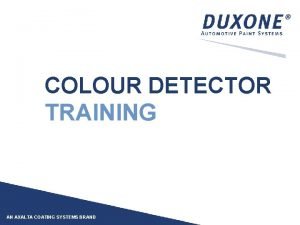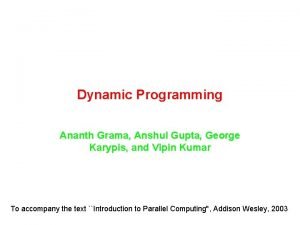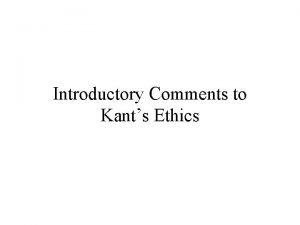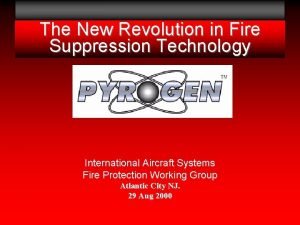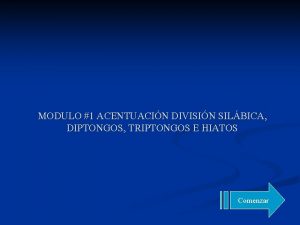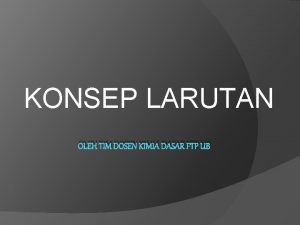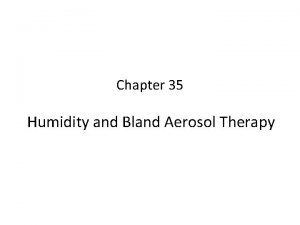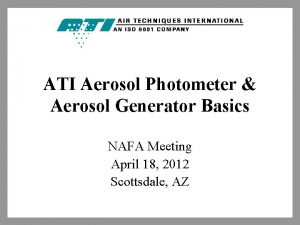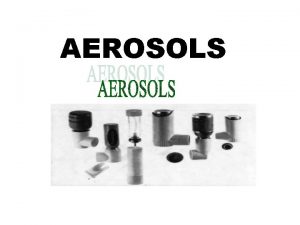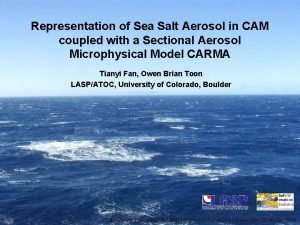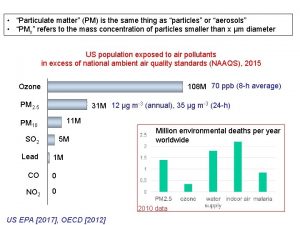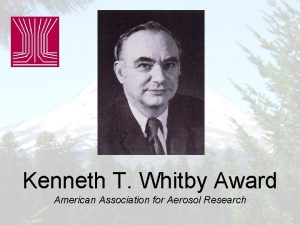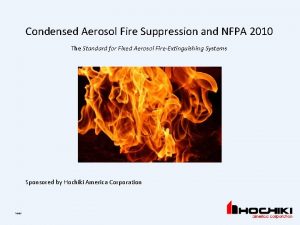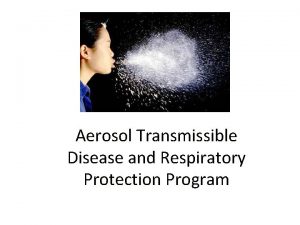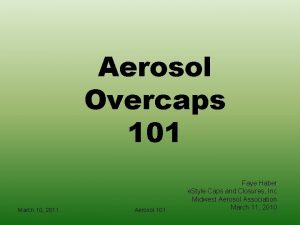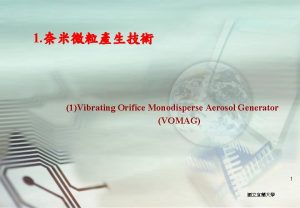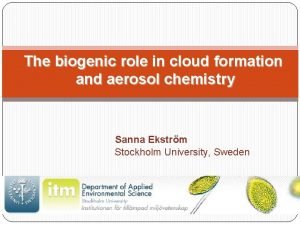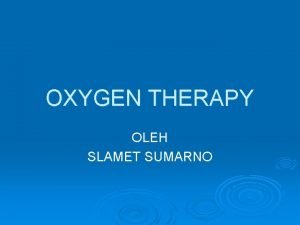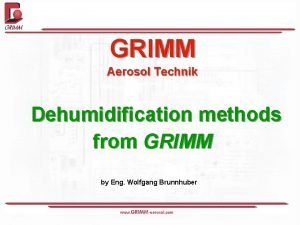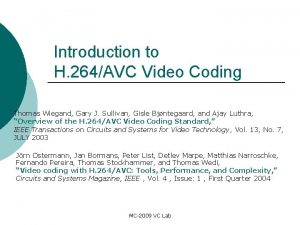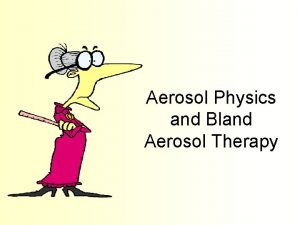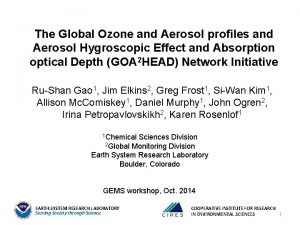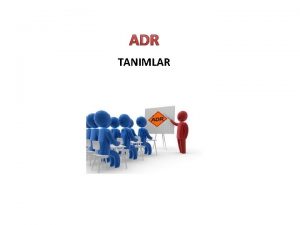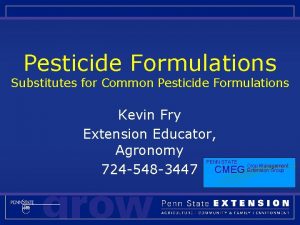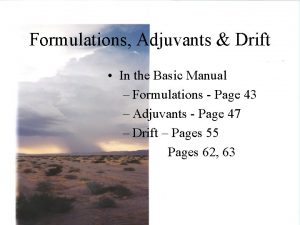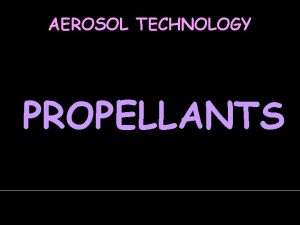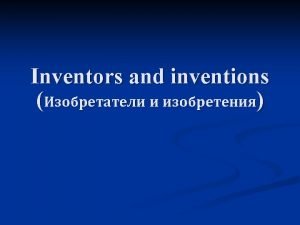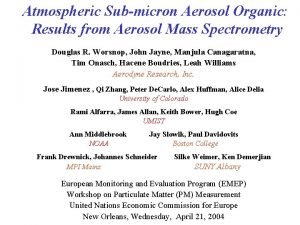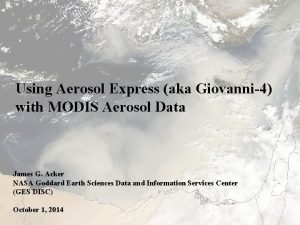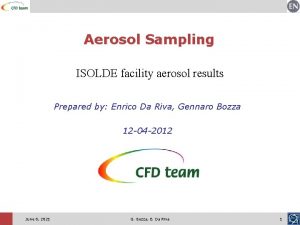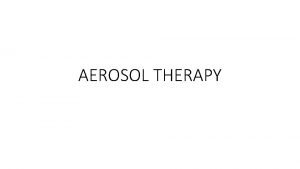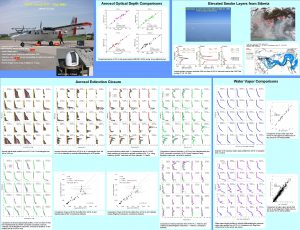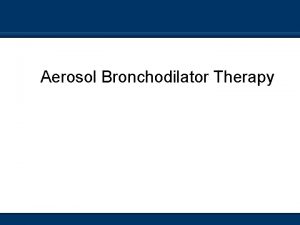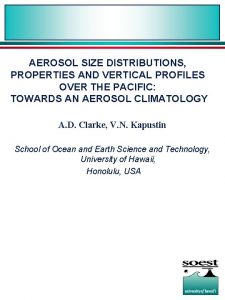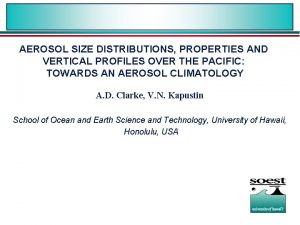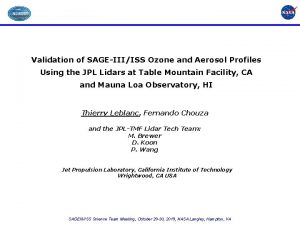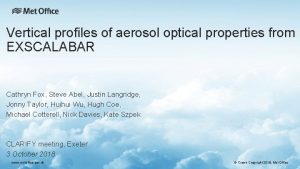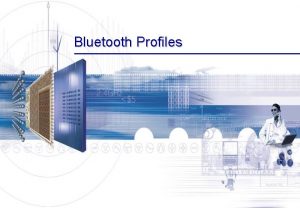Aerosol Formulations The evolution and future profiles of































- Slides: 31

Aerosol Formulations: The evolution and future profiles of available hydrocarbon fluids and diluents - Lubricant Stocks Ralph Beard Director of Corporate Development Functional Products, Inc. SATA Annual Meeting September, 26 2015 1

Areas That We’ll Cover Today S S S S Diluents, solvents carrier fluids, etc…. . A primer on hydrocarbons Refining trends Market impacts on available fluids How base oils are changing Future slates of hydrocarbon diluents Questions and answers 2

“Dead Dinosaurs & Rotten Tree Stumps more likely tiny plants and animals” 3 or

After all those years …………… Crude oil = infinite varieties of Hydrocarbons 101 CH 4 = Methane (natural gas) S C 8 = Octane S C 8 – 16: Range where many hydrocarbon solvents are typically found S C 14 – 22: Range where base oils are typically found C 24+: Waxes, asphalts, residuum 4

Crude Oil Hydrocarbon Distribution 5

Conventional Lubricant Base Oil Refinery 6

Conventional Lubricant Base Oil Refinery Naphtha Diesel Nap VLAC MHAC Diesel 40 LAC 60 200 Crude 750 LVC Atmos. Dist. 2400 MVC Hydro-treater 3500 HVC Blending Vacuum Dist Shipping 7

Refined Products Breakdown 8

Terminology – Lube Base Stocks 101 S S S While sometimes referred to as solvents, diluents etc. , lubricant base stocks/oils are certainly different They both come from various refining & chemical processes Base Stocks/Oils are from higher Mw cuts and are first intention streams, mostly designed for lubricant formulations minus any additives or additional components They are mixtures of materials unless they are customized “synthetic” chemicals They are available in a wide range of viscosities and chemical pedigrees API (American Petroleum Institute) & SAE (Society of Automotive Engineers) both play a key role in defining lubricant performance 9

API Lubricant Base Oil Categories 10

N. A. % Production Shifts – Conventional Base Stocks Category 1998 2015 Group I 56 25 Group II 21 51 Group III <1 1 -2 Naphthenic 21 16 Re-refined < 2* 6* (not an API Category) * Represents various API Categories (> 90% G-ll) 11

North American Base Oil Refining Grades of Products by Type of Plant NA Plants Naphthenic Paraffinic Group III 3 major plants 48 KBPD 5 major plants 74 KBPD 6 major plants 135 KBPD 1 plant 4 KBPD Products by Relative Viscosity X-Light 35/60 Light 80/130 100/130 Neutral 100/120 Neutral Medium 200/300 195/450 Neutral 220 Neutral Heavy 400/800 500/800 Neutral 600 Neutral X-Heavy 1200+ Brightstock 50/90 Neutral 3 c. St (80 N) 4. 5 c. St (100 N) 6 c. St (150 N) A specific plant may not make all viscosity grades 12

Lubricant Base Stock Drivers > 50% of all North American Lubricant demand 13

Lubricant Base Stock Drivers 14

Lubricant Base Stock Drivers Global regulatory and political climate is having a significant impact ü Emissions controls related to vehicles (TPE) ü Fuel efficiency/energy conservation ü Higher CAFE standards ü Smaller engines ü Higher power to weight output ü Faster, faster …………. 15

SAE Engine Oil grades evolution 100% 90% 80% 70% 0 W/XX 60% 5 W/20 50% 5 W/30 40% 10 W/30 10 W/40 30% 20 W/50 20% Mono. Grade 10% 0% 2000 2015 2020 16

Lubricant Base Stock Drivers SAE 0 W/16 & SAE 0 W/8 17

Conventional Base Stocks Ultra Light (~2 c. St) Viscosity Base Oils – Physical Properties Naphthenic Paraffinic Group III Synthetic (PAO) Group IV Viscosity, c. St @100 C 2. 4 2. 3 2. 6 3. 1 2. 0 Viscosity Index < 50 62 100 112 99 Color, Saybolt -6 -5. 7 +30 +30 Specific Gravity @60 F . 887 . 868 . 83 . 798 Flash Point, C 156 149 174 230 220 Noack Volatility, % >90 >75 ~50 36 >90 Pour Point, C -64 -40 -24 -66 Aniline Point, C 75 89 90 102 105 18

Conventional Base Stocks Ultra Light (~2 c. St) Viscosity Base Oils – Chemical Properties Naphthenic Paraffinic Group III Synthetic (PAO) Group IV Viscosity, c. St @100 C 2. 4 2. 3 2. 6 3. 1 2. 0 Sulfur, ppm, typical 105 13 <10 0 Saturates, % ~50 80 >95 99 100 0 ~40 ~50 n/a ~50 20 <5 1 0 Iso-Paraffinics, % Unsaturates, % 19

GTL vs. Conventional Base Stocks Ultra Light (~2 c. St) Viscosity Base Oils Naphthenic Paraffinic Group III Synthetic (PAO) Group IV GTL Stock Viscosity, c. St @100 C 2. 4 2. 6 3. 1 1. 8 2. 7 Viscosity Index < 60 100 112 99 118 Color, Saybolt 25 -30 30 30 +30 Specific Gravity @60 F . 887 . 868 . 83 . 798 . 808 Flash Point, C 156 174 230 220 200 Noack Volatility, % >90 ~50 36 >90 40 Pour Point, C -64 -40 -24 -66 -39 Aniline Point, C 75 90 102 105 114 Sulfur, ppm, typical 105 2. 6 3. 1 2. 0 0 Saturates, % ~50 80 99 100 0 ~40 ~50 n/a 100 ~50 20 >1 0 0 Iso-Paraffinics, % Unsaturates, % 20

Shell’s Perl GTL plant, Ras Laffan, Qatar • • • Uses 1. 6 billion CF natural gas daily 140, 000 BBL/day liquids capacity Initial cost estimate ~$5 B (2003) Final cost >$24 (2012) Crude < $40 BBL = red ink 21

GTL – the future hydrocarbon stream 22

GTL – the future hydrocarbon stream 23

GTL vs Conventional Refining Diesel Fuel Conventional GTL Process Density, g/cm 3 @60 F . 84 . 78 Pounds/Gallon 7. 0 6. 5 Sulfur, % Wt. . 37 0 Aromatics, % 29 <1 Cetane Number 56 >70 24

GTL – Advanced Lubricant Base Oils 25

GTL – Advanced Lubricant Base Oils 26

GTL – Advanced Lubricant Base Oils Middle East – 53% Russia – 37% USA – 5% 27

The Future of Base Stock Streams – Industry experts speak: “For Naphthenics, there will be changes as our stocks will become more hydrotreated. Overall we will probably see a more expensive naphthenic product as these materials will have lighter color, better stability and we may produce tighter cuts that are available to accommodate more niche markets. ” “Lubricant base oil manufacturers around the world will play a continuing, conscientious role in providing formulators with newer approaches to costeffective and even more environmentally responsible options to older lube stock technologies for their finished consumer and industrial applications. Oils that are hydrotreated, isomerized , dewaxed, and hydrofinished to produce more high VI, water-white paraffinic lube oils should find excellent acceptance in diverse and unique applications. ” “ Hydrocarbon-based technologies such as light viscosity base stocks will continue to be available as alternates as regulatory constraints pressure many traditionally acceptable LVP-VOC carrier fluids and diluents. Increasing performance-based parameters driving the available automotive lubricant slate will assure that these products and viscosity cuts will continue to evolve into more unique and viable materials to meet specialty demands as well. ” 28

The future of lube base stocks HYDROISOMERIZING HYDROTREATING HYDROPROCESSING HYDROCRACKING HYDROFINISHING MORE -10 Saybolt Color Approximation +25 More Severe Hydroprocessing +30 29

Special Thanks to……… 30

Thank you! Questions & Answers ? 31
 Duxone colour formulations
Duxone colour formulations Serial monadic dp formulation
Serial monadic dp formulation Imperativo hipotético
Imperativo hipotético Categorical imperative formulations
Categorical imperative formulations Future perfect and future continuous exercises with answers
Future perfect and future continuous exercises with answers Future perfect simple and future continuous exercises
Future perfect simple and future continuous exercises Google mapia
Google mapia Pyrogen aerosol fire suppression system
Pyrogen aerosol fire suppression system Triptongo: ejemplos
Triptongo: ejemplos Contoh aerosol cair
Contoh aerosol cair Pentamidine aérosol
Pentamidine aérosol Humidity therapy
Humidity therapy Aerosol photometer
Aerosol photometer Spray dosage form
Spray dosage form Salt aerosol generator
Salt aerosol generator Aerosol
Aerosol Aerosol
Aerosol Nfpa
Nfpa Aerosol transmissible disease training ppt
Aerosol transmissible disease training ppt Aerosol overcaps
Aerosol overcaps Tsi atomizer
Tsi atomizer Aerosol sampling
Aerosol sampling Humidifikasi hidung adalah
Humidifikasi hidung adalah Estudiais triptongo
Estudiais triptongo Cfa+recyclage aerosol
Cfa+recyclage aerosol Lomudal aerosol
Lomudal aerosol Grimm aerosol technik
Grimm aerosol technik Aerosol kaplar yönetmeliği
Aerosol kaplar yönetmeliği Betts neihart profiles of the gifted and talented
Betts neihart profiles of the gifted and talented H.264 profiles and levels
H.264 profiles and levels Future perfect and future continuous examples
Future perfect and future continuous examples Tenses chart
Tenses chart
